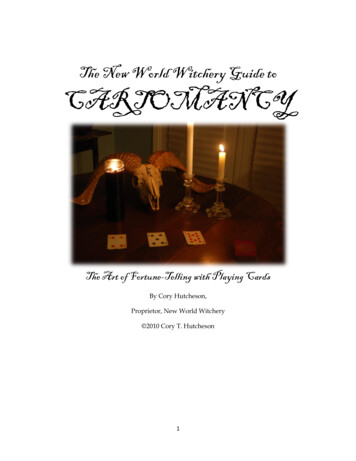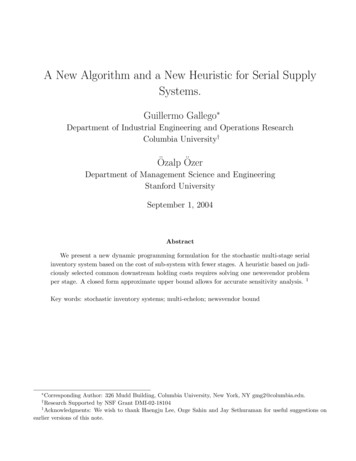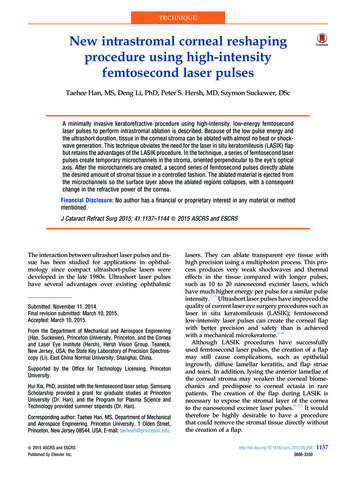
Transcription
The New World Witchery Guide toCARTOMANCYThe Art of Fortune-Telling with Playing CardsBy Cory Hutcheson,Proprietor, New World Witchery 2010 Cory T. Hutcheson1
Copyright NoticeAll content herein subject to copyright 2010 Cory T. Hutcheson. All rights reserved.Cory T. Hutcheson & New World Witchery hereby authorizes you to copy this document in whole or inparty for non-commercial use only. In consideration of this authorization, you agree that any copy ofthese documents which you make shall retain all copyright and other proprietary notices containedherein.Each individual document published herein may contain other proprietary notices and copyrightinformation relating to that individual document.Nothing contained herein shall be construed as conferring, by implication or otherwise any license orright under any patent or trademark of Cory T. Hutcheson, New World Witchery, or any third party.Except as expressly provided above nothing contained herein shall be construed as conferring anylicense or right under any copyright of the author.This publication is provided "AS IS" WITHOUT WARRANTY OF ANY KIND, EITHER EXPRESSED OR IMPLIED,INCLUDING, BUT NOT LIMITED TO, THE IMPLIED WARRANTIES OF MERCHANTABILITY, FITNESS FOR APARTICULAR PURPOSE, OR NON-INFRINGEMENT. Some jurisdictions do not allow the exclusion ofimplied warranties, so the above exclusion may not apply to you. The information provided herein isfor ENTERTAINMENT and INFORMATIONAL purposes only. Any issues of health, finance, or otherconcern should be addressed to a professional within the appropriate field. The author takes noresponsibility for the actions of readers of this material.This publication may include technical inaccuracies or typographical errors. Changes may be periodicallymade to this publication, which will be incorporated in new editions of the publication. The author maymake improvements and/or changes to the content at any time without notice.Should any viewer of a document published by The Open Group respond with information includingfeedback data, such as questions, comments, suggestions, or the like regarding the content of any suchdocument, such information shall be deemed to be non-confidential and the author shall have noobligation of any kind with respect to such information and shall be free to reproduce, use, disclose anddistribute the information to others without limitation. Further, the author shall be free to use anyideas, concepts, know-how or techniques contained in such information for any purpose whatsoeverincluding but not limited to developing, manufacturing and marketing products incorporating suchinformation.All redistribution and citation of this work must contain references to both title and author.2
ContentsOverviewp. 4Red & Blackp. 5The Suitsp. 5Pips & Facesp. 6The Cardsp. 7Diamondsp. 7Clubsp. 9Heartsp. 10Spadesp. 12The Spreadsp. 14One-Cardp. 15Three-Cardp. 16Five-Card (Full Spread)p. 17Final Notesp. 21Bibliographyp. 213
OverviewI’ve always been a fan of what’s referred to as “secrets in plain sight.” I love the idea that certaineveryday objects have deeply mystical significance which needs but the right pair of eyes to unveil it.Keys, coins, bottles, and boxes all find their way into my magical life and onto my household shelves,where most people ignore them. I, on the other hand, can turn to them at a moment’s notice and usethem as tools to open up the mysterious and wonderful world around me. So it is with playing cards.In this small book, what I would like to do is explain my personal system of card divination, as well assome of the variants and influences which have shaped my practice. I’m not going to dive into anextensive history of playing cards or tarot cards, as those subjects are well-covered and welldocumented in other sources. However, a little of the history that sometimes slips through the cracks(especially regarding playing cards) might be worth mentioning here.While the absolute origin of pictographic cards is unknown, many folks believe they came out of India,China, or Turkey, or with the travelling Romany people (also frequently called “Gypsies”). What isknown is that by the 1500’s, playing cards were very popular with the lower classes, and often cited as avice by clerical and governmental documents throughout Europe. They received wide-spreadappreciation from the highest ranks, including Bohemian emperor Rudolph II and Madame Lenormand,who is reputed to have provided psychic guidance to Napoleon’s empress, Josephine. Yet cards havealmost always been popular among the lower classes, too. Cards came to America with settlers, sailors,and soldiers. In fact, in the late 1700’s, a popular ballad called “The Soldier’s Prayer-Book” described thesuits, pips, and enumeration of playing cards in terms of biblical metaphor. For example, the fivesrepresent the five wounds of Christ, the nines are the nine lepers healed by Jesus, and the tens are theTen Commandments. While this song may have been a white-wash for gambling soldiers eager to keepone of the few portable entertainments allowed them, it does register an important point: cards makewonderful tools for metaphoric interpretation.So why playing cards instead of tarot cards? For one thing, playing cards of one kind or another havebeen more or less easily accessible since the 1600’s, and are extremely versatile. The cards you play agame of blackjack with one day can be used to reveal the future the next. They also travel well in apocket and are easily replaced if they get torn or damaged. Plantation owners in the antebellum Southoften thought little of slaves having decks of playing cards to amuse themselves in their few off hours(though in some places stricter masters prohibited them altogether). William Wells Brown, whoprovided a slave narrative for a character named “Uncle Frank,” claimed that each plantation also had atleast one fortune-teller somewhere on the premises, and at least few of them used playing cards.Today, playing cards are an excellent way of divining even in plain sight. No one thinks much of twopeople over a table full of diamonds, spades, clubs, and hearts, while a Devil or Lovers card might raiseeyebrows.My own system of playing card divination is largely based on the book It’s All in the Cards, by ChitaLawrence and the rhyme “For the Witch of Poor Memory” by Dawn Jackson, with a significant amountof additional material I’ve picked up from other books, teachers, and experiences over time. What Ioutline here will be my own understanding of these cards, so please do not take it as gospel, and find amethod that works for you.4
Red & BlackLike most who practice cartomancy, I break the major meanings of the cards down by color and suits.However, unlike a lot of other practitioners, I don’t ascribe these suits to tarot parallels or elementalattributes. There are some connections, of course, as hearts and cups both signal emotion-basedinterpretations, but it’s not a hard-and-fast link.First, black cards indicate “negative” or “no” answers, while red cards are “positive” or “yes” answers.This is most important in short readings, which I’ll address in a later post. Some will say that havingmore black cards than red is a sign of negativity, but honestly, the only truly “negative” cards in anextended reading are the spades, in my opinion.Getting hung up on the red vs. black significance can short circuit a reading, too. While it is helpful in away to be able to “summarize” the reading based on the proportion of “positive” red cards to “negative”black ones, it might also predispose you as a reader to offer a particularly strong interpretation as youcontinue with the session. Seeing lots of red cards may make you think “Oh, a very pleasant reading!Good news for the client!” but when you see that, in fact, you’ve actually got a Seven of Diamonds andan Ace and Seven of Hearts in your reading, there are distinct possibilities for a negative reading thatyou might ignore based on your positive bias.Basically, as always with divinatory methods, keep an open mind. Use the colors of the cards as a looseguide, but don’t get invested in them before thinking about the individual card meanings.The SuitsIf you’ve had any experience with tarot, understanding the different meanings for each suit might beeasier. Then again, it might be harder, as many tarot readers have preset notions about suitcorrespondences. I advise that a reader spend time with the cards and determine what patternsemerge from continual use. But I will definitely admit that having at least a rough concept of what eachsuit means can be incredibly helpful. For me, I look at the suits in the following way:Hearts – Family, friends, love, and lovers. Also emotions and things which are deeply felt.Clubs – Work and business. One’s “calling” or destiny. Also conflict, discussion, and debate.Diamonds – Money, luck, fortune, happiness. Also news, letters, and socializing.Spades – Tears, suffering, woe. War, fighting, violence. Also change, warning, and doubts/fears.I’ll get into each of these suits a little more when I break down the individual cards, but this should giveyou some idea what I see when I do a layout for a reading. If I see lots of diamonds and clubs, I knowthat someone’s got some good work he or she will be well compensated for coming around the bend.All hearts means that the client is emotionally invested in the reading, or that he or she is dealing withdeep family or friendship questions. Spades and clubs together would be a sign that the client’s jobmight be in jeopardy, or that work is very unfulfilling for him or her.Next, we’ll get into the significance of the pips on the cards, but it is good to keep the overall meaningsof the suits in mind as we go forward.5
Pips and FacesThere are lots of different systems of interpreting the card numbers and the royals. Some are fairlysimplistic (mine definitely are) and some get incredibly detailed, looking at astrological andnumerological significance in cabbalistic and ceremonial magical contexts. I’m not a particularly goodceremonialist, so I tend to use a fairly straightforward system focusing on key concepts associated witheach number. I can probably demonstrate better than I can explain, so here’s my numbering system.Aces – Beginnings; Primary or Solitary thingsTwos – Pairs; Couples; ExchangeThrees – Growth; WishesFours – Decisions; Stagnation; ChoicesFives – Groups; Bodily things; Gains/LossesSix – PathsSevens – Epitome cards*; Inversions; TroubleEights – Talking; IdeasNines – Patience; Ambition; ExpansionTens – Completion; EndingsJacks – Youth; Children; Messages; PeersQueens – Women or a particular woman; Beauty; Mothers; Nurses; TeachersKings – Men or a particular man; Wisdom; Age; Power; Judges*A note on “epitome” cards – the Sevens of each suit represent the most concentrated form ofthat suit. Often, there’s a somewhat negative connotation to this intensity. Yet, this does notnecessarily mean all good or all bad. For example, the seven of spades can mean “tears” as anepitome card, but if those tears are near lots of red cards, they are likely tears of joy.The number combinations can also lead to a certain amount of interpretation. For instance, if you hadseveral threes and nines, that would guide you towards a reading about opportunities and very quickgrowth (because both cards are about growth/expansion). A seven, five, and four might indicate badchoices and losses that come out of those choices. A king with a six might mean a teacher or elder isgoing to help guide the questioner in a new direction.Royal cards (or “face cards”) also have a certain potency that the numeric cards lack. I sometimesinclude aces as a face card, but this really depends on the reading and the number of other face cardsaround it. It’s sort of like spiritual blackjack—it can be the highest or lowest value depending on theother cards. The other face cards usually represent particular people or major events in the subject’slife. Getting a king and a queen of the same suit can often indicate “parents” or the parental guidancewhich shaped the questioner’s life. You’ll see more about these as we explore them in depth later on,but for now just know that royals, aces, and sevens all mean “pay attention to this reading.” There aresome divinatory systems (such as the card-reading taught in curanderismo) which also remove thequeens from the deck before reading. This dates back to a European practice based on a specific deck,but don’t be surprised if you don’t see them in someone’s reading. As a final word on royals, there aretwo special royals in my system of divination: the King and Queen of Hearts. Depending on the genderof the client, one of these cards will represent him or her (the king for a man, the queen for a woman).We’ll look at how that works later on, though. All of these interpretations are also deeply linked to thesuits, of course, and to where they fall during the reading.Now, on to the individual cards.6
The CardsNow we’re going to look at individual cards and their significance in my readings. I’ll basically tell you afew key words, and then elaborate a bit on potential interpretations of these cards. Most of my systemcomes out of years of practice using playing cards for divination, as well as for games. I have found thatin some cases, my personal work with a particular card has shown me a meaning different from the oneI originally learned. When it comes to these sorts of fortune-telling methods, practice makes perfect.Now, onto the cards! Let’s start with:DiamondsRemember that diamonds in general signify money, fortune, luck, and happiness. They also can relateto messages or news, or social interaction.Ace – A letter; A coin. The Ace of Diamonds indicates some new money or new information entering thequestioner’s life. It can also have to do with a sudden shift in luck—if preceded and followed by spades,that could mean bad luck. Additi
Further, the author shall be free to use any ideas, concepts, know-how or techniques contained in such information for any purpose whatsoever including but not limited to developing, manufacturing and marketing products incorporating such information. All redistribution and citation of this work must contain references to both title and author. 3 Contents Overview p. 4 Red & Black p. 5 The .











